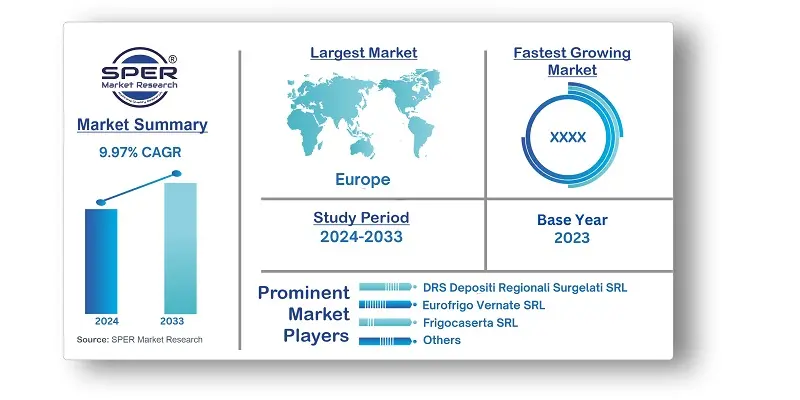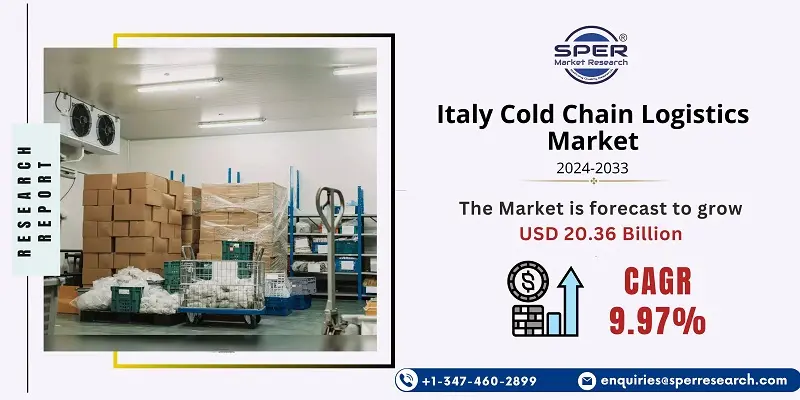
Italy Cold Chain Logistics Market Growth, Size, Trends, Share, Revenue, Demand and Future Outlook
Italy Cold Chain Logistics Market Size- By Service, By Temperature Type, By Application- Regional Outlook, Competitive Strategies and Segment Forecast to 2033
| Published: Jul-2024 | Report ID: AMIN24152 | Pages: 1 - 109 | Formats*: |
| Category : Automotive & Transportation | |||
- May 2022: Bomi Group, under the Picking Farma brand, announces the impending inauguration of a new logistical hub for the healthcare industry close to Madrid. Work on the warehouse, which has already started, is expected to cost 15 million euros and generate 150 employment. The new logistics platform will be added to the seven that are now in Spain, which include two in the Canary Islands, four in Catalonia, and one close to Madrid.
- In April 2022, Tendron Pharma, a division of Tendron Transports, an independent business devoted to the transportation of pharmaceutical products since 1963, will be acquired by Bomi Group, a global leader in integrated logistics serving the healthcare industry. Transporting medications and equipment from the pharmaceutical factory to distributors in the Ile-de-France region, such as pharmacies, hospitals, and clinics, Tendron Pharma has a fleet of twenty-five owned vehicles, consisting of vans and trucks, all of which are kept at a controlled temperature of +15+25° C.


| Report Metric | Details |
| Market size available for years | 2020-2033 |
| Base year considered | 2023 |
| Forecast period | 2024-2033 |
| Segments covered | By Service, By Temperature Type, By Application |
| Regions covered | Eastern Region, Southern Region, Northern Region, Western Region |
| Companies Covered | DRS Depositi Regionali Surgelati SRL, Eurofrigo Vernate SRL, Fridocks General Warehouses and Frigoriferi SR, Frigocaserta SRL, Frigogel SRL, Frigoscandia SPA, Horigel SRL, Safim Logistics, Sodele Magazzini Generali Frigoriferi SRL, Soluzioni Logistiche Freddo SRL In Breve SL Freddo SRL, Others |
- Food and Beverage Companies
- Pharmaceutical and Healthcare Companies
- Retailers
- Logistics and Transportation Providers
- Cold Storage Facility Operators
| By Services: |
|
| By Temperature Type: |
|
| By Application: |
|
- Italy Cold Chain Logistics Market Size (FY’2024-FY’2033)
- Overview of Italy Cold Chain Logistics Market
- Segmentation of Italy Cold Chain Logistics Market By Services (Storage, Transportation, Blast Freezing, Labelling, Inventory Management)
- Segmentation of Italy Cold Chain Logistics Market By Temperature Type (Ambient, Chilled, Frozen)
- Segmentation of Italy Cold Chain Logistics Market By Application (Horticulture, Dairy Products, Meats and Fish, Processes Food Products, Pharma, Life Science and Chemicals, Others)
- Expansion Analysis of Italy Cold Chain Logistics Market
- Problems and Obstacles in Italy Cold Chain Logistics Market
- Competitive Landscape in the Italy Cold Chain Logistics Market
- Impact of COVID-19 and Demonetization on Italy Cold Chain Logistics Market
- Details on Current Investment in Italy Cold Chain Logistics Market
- Competitive Analysis of Italy Cold Chain Logistics Market
- Prominent Players in the Italy Cold Chain Logistics Market
- SWOT Analysis of Italy Cold Chain Logistics Market
- Italy Cold Chain Logistics Market Future Outlook and Projections (FY’2024-FY’2033)
- Recommendations from Analyst
1.1. Scope of the report1.2. Market segment analysis
2.1. Research data source2.1.1. Secondary Data2.1.2. Primary Data2.1.3. SPER’s internal database2.1.4. Premium insight from KOL’s2.2. Market size estimation2.2.1. Top-down and Bottom-up approach2.3. Data triangulation
4.1. Driver, Restraint, Opportunity and Challenges analysis4.1.1. Drivers4.1.2. Restraints4.1.3. Opportunities4.1.4. Challenges4.2. COVID-19 Impacts of the Italy Cold Chain Logistics Market
5.1. SWOT Analysis5.1.1. Strengths5.1.2. Weaknesses5.1.3. Opportunities5.1.4. Threats5.2. PESTEL Analysis5.2.1. Political Landscape5.2.2. Economic Landscape5.2.3. Social Landscape5.2.4. Technological Landscape5.2.5. Environmental Landscape5.2.6. Legal Landscape5.3. PORTER’s Five Forces5.3.1. Bargaining power of suppliers5.3.2. Bargaining power of buyers5.3.3. Threat of Substitute5.3.4. Threat of new entrant5.3.5. Competitive rivalry5.4. Heat Map Analysis
6.1. Italy Cold Chain Logistics Market Manufacturing Base Distribution, Sales Area, Product Type6.2. Mergers & Acquisitions, Partnerships, Product Launch, and Collaboration in Italy Cold Chain Logistics Market
7.1. Italy Cold Chain Logistics Market Size, Share and Forecast, By Services, 2020-20267.2. Italy Cold Chain Logistics Market Size, Share and Forecast, By Services, 2027-20337.3. Storage7.4. Transportation7.5. Blast Freezing7.6. Labelling7.7. Inventory Management
8.1. Italy Cold Chain Logistics Market Size, Share and Forecast, By Temperature Type, 2020-20268.2. Italy Cold Chain Logistics Market Size, Share and Forecast, By Temperature Type, 2027-20338.3. Ambient8.4. Chilled8.5. Frozen
9.1. Italy Cold Chain Logistics Market Size, Share and Forecast, By Application, 2020-20269.2. Italy Cold Chain Logistics Market Size, Share and Forecast, By Application, 2027-20339.3. Horticulture9.4. Dairy Products9.5. Meats and Fish9.6. Processes Food Products9.7. Pharma, Life Science and Chemicals9.8. Others
10.1. Italy Cold Chain Logistics Market Size and Market Share
11.1. Italy Cold Chain Logistics Market Size and Market Share By Region (2020-2026)11.2. Italy Cold Chain Logistics Market Size and Market Share By Region (2027-2033)11.3. Eastern Region11.4. Southern Region11.5. Northern Region11.6. Western Region
12.1. DRS Depositi Regionali Surgelati SRL12.1.1. Company details12.1.2. Financial outlook12.1.3. Product summary12.1.4. Recent developments12.2. Eurofrigo Vernate SRL12.2.1. Company details12.2.2. Financial outlook12.2.3. Product summary12.2.4. Recent developments12.3. Fridocks General Warehouses and Frigoriferi SR12.3.1. Company details12.3.2. Financial outlook12.3.3. Product summary12.3.4. Recent developments12.4. Frigocaserta SRL12.4.1. Company details12.4.2. Financial outlook12.4.3. Product summary12.4.4. Recent developments12.5. Frigogel SRL12.5.1. Company details12.5.2. Financial outlook12.5.3. Product summary12.5.4. Recent developments12.6. Frigoscandia SPA12.6.1. Company details12.6.2. Financial outlook12.6.3. Product summary12.6.4. Recent developments12.7. Horigel SRL12.7.1. Company details12.7.2. Financial outlook12.7.3. Product summary12.7.4. Recent developments12.8. Safim Logistics12.8.1. Company details12.8.2. Financial outlook12.8.3. Product summary12.8.4. Recent developments12.9. Sodele Magazzini Generali Frigoriferi SRL12.9.1. Company details12.9.2. Financial outlook12.9.3. Product summary12.9.4. Recent developments12.10. Soluzioni Logistiche Freddo SRL In Breve SL Freddo SRL12.10.1. Company details12.10.2. Financial outlook12.10.3. Product summary12.10.4. Recent developments12.11. Others
SPER Market Research’s methodology uses great emphasis on primary research to ensure that the market intelligence insights are up to date, reliable and accurate. Primary interviews are done with players involved in each phase of a supply chain to analyze the market forecasting. The secondary research method is used to help you fully understand how the future markets and the spending patterns look likes.
The report is based on in-depth qualitative and quantitative analysis of the Product Market. The quantitative analysis involves the application of various projection and sampling techniques. The qualitative analysis involves primary interviews, surveys, and vendor briefings. The data gathered as a result of these processes are validated through experts opinion. Our research methodology entails an ideal mixture of primary and secondary initiatives.



Frequently Asked Questions About This Report
PLACE AN ORDER
Year End Discount
Sample Report
Pre-Purchase Inquiry
NEED CUSTOMIZATION?
Request CustomizationCALL OR EMAIL US
100% Secure Payment






Related Reports
Our Global Clients
Our data-driven insights have influenced the strategy of 200+ reputed companies across the globe.




















